Edge Data Center Market by Component (Solutions, Services), Facility Size (Small & Medium Facilities, Large Facility), Vertical (IT & Telecom, Manufacturing, Automotive, Healthcare & Lifesciences, Manufacturing), & Region - Global Forecast to 2028
Edge Data Center Market Forecast
The Edge Data Center Market is projected to expand at a CAGR of 23.2% during the forecast period to reach USD 29.6 billion by 2028, size was valued USD 10.4 billion in 2023. Some important factors that boost the growth of the edge data center include the increasing demand for smart city initiatives and edge data centers as a service, which would create numerous opportunities for edge data center vendors.
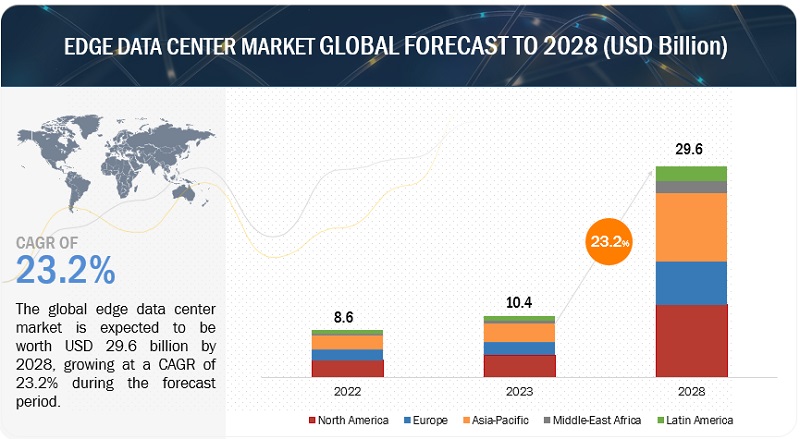
To know about the assumptions considered for the study, Request for Free Sample Report
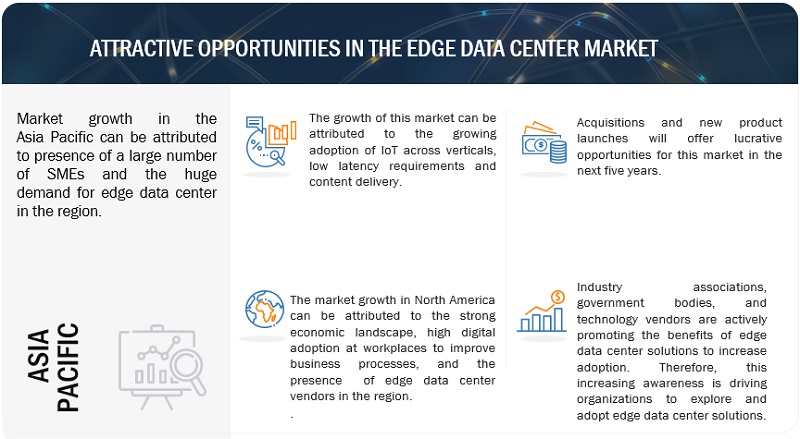
To know about the assumptions considered for the study, download the pdf brochure
Recession Impact on the Edge Data Center Market
The edge computing market has witnessed direct and indirect impacts due to the economic slowdown. Some of the significant implications include reduced investments, delayed deployments, canceled client projects, increased focus on cost optimization, the demand for edge solutions, impact on edge device manufacturers, and focus on efficiency and automation. The recession has slightly affected the manufacturing sector, including the production of edge devices and sensors. If manufacturers face continuously decreased demand or financial difficulties, it could lead to supply chain disruptions, increased prices, or delays in delivering edge computing hardware. Further, edge computing typically requires upfront infrastructure, hardware, and software investments. Due to the economic slowdown, organizations are now more cautious about capital expenditures and are less willing to take on the financial burden of implementing and maintaining edge computing solutions. The uncertainties and risks associated with new technology adoption may deter organizations from pursuing edge computing initiatives.
On the other hand, a recession can also create new demands and opportunities for edge computing. As organizations seek to optimize operations and reduce costs, they may recognize the value of edge computing in improving real-time data analysis, reducing bandwidth usage, and enabling faster decision-making. This increased demand could drive innovation and investment in edge computing solutions.
Edge Data Center Market Dynamics
Driver: Role of 5G Deployment
5G deployment refers to the rollout and implementation of the fifth generation of wireless technology, 5G. 5G is a transformative advancement in mobile communication that promises significantly faster data speeds, lower latency, increased network capacity, and the ability to support many connected devices. It represents a significant leap from the previous 4G/LTE technology to revolutionize various industries and applications.
The deployment of 5G networks would drive the demand for edge data centers. 5G technology requires lower latency and higher bandwidth to deliver its full potential. Edge data centers are essential to support 5G applications, as they can process data locally and reduce the backhaul traffic to the core data centers. The integration of 5G and the edge data center market is a symbiotic relationship that enhances the capabilities and potential of both technologies. 5G and edge data centers complement each other to address the demands of modern applications and services. 5G technology’s ultra-low latency perfectly matches edge data centers. The combination allows quick data transfer from connected devices to nearby edge data centers, enabling real-time processing and responses.
Restraint: Regulatory Compliance
Being distributed across various locations, Edge data centers must adhere to a complex web of regional, national, and international laws governing data handling and storage. Different countries and regions have data privacy laws, such as the GDPR in Europe, the CCPA in the United States, and the PDPA in Singapore. These laws impose strict requirements on collecting, processing, storing, and sharing personal data. Edge data centers must comply with the specific regulations of each jurisdiction where they operate. Some countries have data localization laws that mandate certain types of stored data within their borders. Edge data centers, being decentralized, may need to ensure that data originating from a specific country remains within that country’s borders. This requirement can add complexity to data management and increase the number of edge data centers needed to comply with different data localization rules. Edge data centers in one country may need to transfer data to a centralized data center or cloud provider in another country for various reasons, such as backup and disaster recovery. Such cross-border data transfers must comply with data protection laws governing international data flows, which can involve negotiating data transfer agreements or adopting approved mechanisms, such as Standard Contractual Clauses (SCCs).
Opportunity: Growing demand for Edge Data Center as a Service
Edge Data Center as a Service (EDCaaS) is a model that offers businesses and organizations the option to leverage edge data centers and their capabilities without needing to build and manage their dedicated edge infrastructure. EDCaaS providers offer edge computing resources and services on a subscription or pay-as-you-go basis, making it easier for companies to access the benefits of edge data centers without significant upfront investments. EDCaaS eliminates the need for businesses to invest in building and maintaining their edge data centers, which can be capital-intensive. Instead, companies can subscribe to EDCaaS offerings and pay for the edge computing resources they consume. This pay-as-you-go model allows organizations to manage their IT infrastructure costs more efficiently. Setting up a dedicated edge data center can be time-consuming, involving various stages such as site selection, construction, and configuration. EDCaaS providers have pre-established edge data center locations and infrastructure, allowing businesses to access edge resources and deploy edge-enabled applications without delays. EDCaaS providers offer flexible resource allocation, allowing companies to scale their edge computing capacity based on demand. Organizations can easily adjust their edge resources as their computing needs evolve without the constraints of managing physical infrastructure.
Challenge: High-speed network connection in remote areas
The challenge involves enabling fast and reliable network connections for edge data centers located in remote areas. Edge data centers are close to data sources, end-users, and network access points; this minimizes the distance data must travel, reducing the latency between data generation and processing. However, remote locations lack robust network infrastructure, causing difficulty in establishing high-speed connections. Overcoming this challenge requires addressing infrastructure limitations, latency due to distance, adverse environmental conditions, high deployment costs, and ensuring consistent power supply. Solutions include wireless technologies, renewable energy sources, hybrid networking approaches, community partnerships, efficient networking protocols, and thorough ROI evaluations. The aim is to connect remote edge data centers efficiently, facilitating smooth data flow and optimal service delivery.
Edge Data Center Market Ecosystem
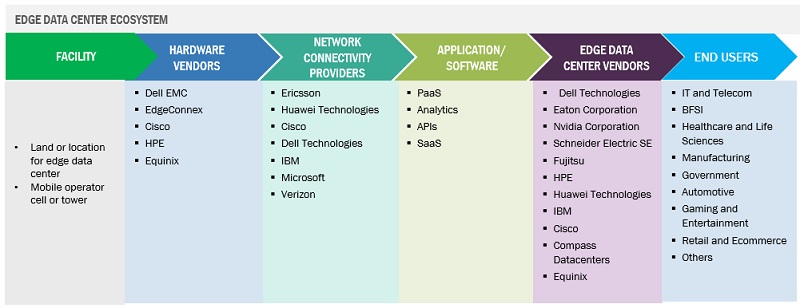
This section highlights the edge data center ecosystem. The ecosystem comprises a facility, hardware vendors, network connectivity vendors, application/software, edge data center vendors, and the end user. Organizations have been utilizing edge data centers to ensure quick decision-making and enhanced business performance in the long run.
Edge data center ecosystems vary by provider. Edge data center vendors focus on delivering edge services that focus on critical areas such as low latency, privacy, and data sovereignty. The network connectivity providers and hardware providers form the most vital part of the edge data center ecosystem. Vendors in the edge data center market have a strong partner network for distributing edge data center products and services. The edge data center ecosystem includes various industries such as healthcare, IT and telecom, retail, manufacturing, etc.
Based on services, the consulting segment will witness the second-highest CAGR during the forecast period.
Consulting services in the edge data center domain involve offering expertise and guidance to organizations planning, designing, implementing, or optimizing edge data center solutions. These services help businesses navigate the complexities of edge computing and ensure that their edge data centers are efficient, reliable, and aligned with their strategic goals.
Based on vertical, the gaming and entertainment vertical will witness the second-highest growth during the forecast period.
Edge data centers are critical in the digital transformation and the growing demand for real-time, data-driven applications. They address the limitations of centralized data centers by bringing computation closer to where it is needed, enabling organizations to harness the benefits of low latency, improved performance, and enhanced user experiences. This proximity minimizes latency, crucial for online gaming, where even milliseconds can impact gameplay. Gamers experience faster response times, ensuring a smoother and more immersive gaming experience. Edge data centers cache and distribute game content, updates, and patches; this reduces the load on central servers and accelerates content delivery. In the streaming context, edge data centers are critical for platforms that offer game streaming services, allowing gamers to play resource-intensive games on a wide range of devices without needing powerful local hardware.
The US market contributes the largest share of North America’s edge data center market during the forecast period.
The US is home to several leading-edge data center providers, such as Dell, NVIDIA Corporation, Hewlett Packard Enterprise, IBM, 365 Data Centers, Cisco, Panduit Corporation, Equinix, Systel, Vertiv Group, CommScope, The Siemon Company, Flexential Corporation, and EdgeConnex, which is another driving factor for the growth of the edge data center market in the country. The adoption of edge data centers was the largest in the US during the COVID-19 outbreak. A higher percentage of homes in the US have subscribed to Netflix, Hulu, or Amazon. Edge data center has helped such streaming service providers enhance end users’ experience. Besides, there has also been tremendous growth in the usage of video conferencing applications. Edge AI offers unemployed people new career prospects. Telecom operators in the US would spend USD 380 billion on 5G till 2025 to focus on new services for consumers and enterprises alike. Hence, 5G-based applications represent a strong potential for adopting edge data centers in North America.
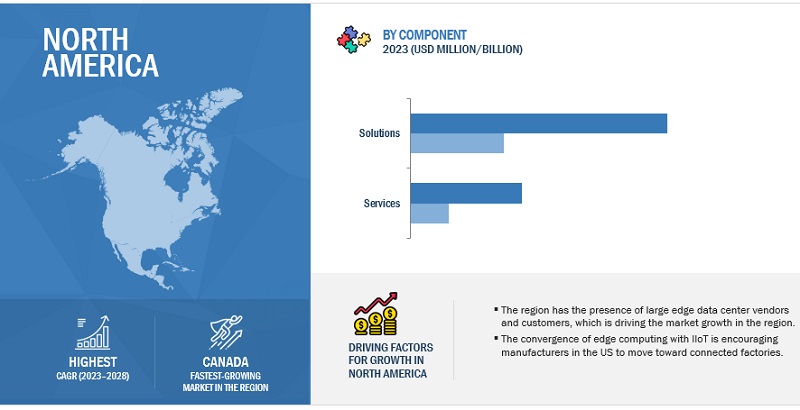
Key Market Players
The primary technology vendors in the market include Dell (US), Eaton (Ireland), IBM (US), NVIDIA (US), Schneider Electric (France), Fujitsu (Japan), HPE (US), Cisco (US), Huawei (China), 365 Data Centers (US), Rittal (Germany), Panduit (US), Equinix (US), Sunbird (US), Vertiv Group (US), HUBER+SUHNER (Switzerland), CommScope (US), Siemon (US), Flexential (US), EdgeConneX (US), Compass Datacenters (US), Zenlayer (US), Vapor IO (US), Zella DC (Australia), Smart Edge Data Centers (UK), Ubiquity (US), DartPoints (US), Edge Centres (Australia), and SBA Edge (US). Most key players have adopted partnerships and product developments to cater to the demand for edge data centers.
Get online access to the report on the World's First Market Intelligence Cloud
- Easy to Download Historical Data & Forecast Numbers
- Company Analysis Dashboard for high growth potential opportunities
- Research Analyst Access for customization & queries
- Competitor Analysis with Interactive dashboard
- Latest News, Updates & Trend analysis
Request Sample Scope of the Report
Get online access to the report on the World's First Market Intelligence Cloud
- Easy to Download Historical Data & Forecast Numbers
- Company Analysis Dashboard for high growth potential opportunities
- Research Analyst Access for customization & queries
- Competitor Analysis with Interactive dashboard
- Latest News, Updates & Trend analysis
|
Report Metrics |
Details |
|
Market size value in 2023 |
USD 10.4 billion |
|
Revenue forecast for 2028 |
USD 29.6 billion |
|
Growth Rate |
23.2% CAGR |
|
Market size available for years |
2020–2028 |
|
Base year considered |
2022 |
|
Forecast period |
2023–2028 |
|
Forecast units |
Billion (USD) |
|
Segments Covered |
Component (Solutions, Services), Facility Size, and Vertical |
|
Geographies Covered |
North America, Latin America, Europe, Middle East & Africa, and Asia Pacific |
|
Companies Covered |
The key technology vendors in the market include Dell (US), Eaton (Ireland), IBM (US), NVIDIA (US), Schneider Electric (France), Fujitsu (Japan), HPE (US), Cisco (US), and more. |
This research report categorizes the edge data center market based on components (solutions, services), facility size, verticals, and regions.
Based on the Component:
-
Solution
- DCIM
- Power
- Cooling
- Networking equipment
- Others (IT racks & enclosures)
-
Services
- Consulting
- Integration & Implementation
- Managed
Based on the Facility Size:
- Small & Medium Facility
- Large Facility
Based on the Vertical:
- IT & Telecom
- BFSI
- Healthcare & Lifesciences
- Manufacturing
- Government
- Automotive
- Gaming & Entertainment
- Retail & eCommerce
- Other Verticals (Mining, Agriculture)
Based on Regions:
-
North America
- United States
- Canada
-
Europe
- United Kingdom
- Germany
- France
- Rest of Europe
-
Asia Pacific
- China
- Japan
- India
- Rest of Asia Pacific
-
Middle East & Africa
- United Arab Emirates
- Kingdom of Saudi Arabia
- South Africa
- Rest of the Middle East & Africa
-
Latin America
- Brazil
- Rest of Latin America
Recent Developments:
- In July 2023, Dell announced a collaboration with Airspan to deliver a pre-integrated solution for wireless edge deployments. This solution combines Dell’s modular data center and Airspan’s advanced wireless networking technology, providing a seamless and efficient solution for wireless edge deployments.
- In July 2023, Siemon launched new EagleEye Red software for managing data center and LAN networks. Its multi-tiered network discovery protocols allow users to quickly scan and find all IP-based devices within their network and position assets at their correct locations.
- In July 2023, Flexential announced a significant expansion of FlexAnywhere Platform in 2023 with over 110MW Under Development across Atlanta, GA and Hillsboro, OR.
- In June 2023, Dell has recently expanded its Dell Private Wireless Program, aiming to offer secure enterprise connectivity for edge locations. The program now supports Airspan and Druid wireless solutions, providing businesses with enhanced options for reliable wireless connectivity at the edge.
- In June 2023, HPE announced an extended partnership with Equinix to expand the HPE GreenLake private cloud portfolio within Equinix International Business Exchange (IBX) data centers. This partnership involves pre-provisioning HPE GreenLake for Private Cloud Enterprise and HPE GreenLake for Private Cloud Business Edition at selected Equinix data centers worldwide. This move aims to provide customers with swift access to a wide array of private cloud solutions, enabling them to achieve speed, agility, flexibility, and choice in their hybrid cloud strategy.
- In May 2023, NVIDIA launched a new class of large-memory AI supercomputer, the NVIDIA DGX. The NVIDIA GH200 Grace Hopper Superchips and the NVIDIA NVLink Switch System drive this powerful system. It facilitates the development of massive, next-generation models for generative AI language applications, recommender systems, and data analytics workloads.
- In May 2023, 365 Data Centers expanded its comprehensive enterprise service capabilities to encompass eight new data center locations and 35 new Points of Presence (PoPs). This expansion benefits agents, resellers, and direct customers by providing a unified solution with one Master Service Agreement (MSA), one support team, and one invoice for a full-stack offering, including colocation, network, cloud, and IT support services.
- In April 2023, an MoU was signed between Cisco and Leonardo, and within the framework of the MoU, activities will be supported by dedicated working groups to periodically and jointly identify business opportunities and areas of technical cooperation to meet market demands, particularly in the sectors of cybersecurity, secure networking, IoT, digital workplace, and cloud edge computing.
- In January 2022, Cisco expanded its Cisco Catalyst 9000 portfolio; this helps bring enterprise-grade switching capabilities to the industrial edge for industries operating in harsh conditions and supporting critical infrastructure such as utilities, oil and gas, roadways, and rail.
Frequently Asked Questions (FAQ):
What is an edge data center?
An edge data center, also known as an edge computing facility, refers to a decentralized computing facility located physically closer to the sources of data and the end-users it serves. Unlike traditional centralized data centers, often situated in larger urban areas, edge data centers are strategically placed near where data is generated and consumed. The primary purpose of edge data centers is to reduce latency, improve response times, and enhance the performance of applications/services that require real-time data processing.
Which country is an early adopter of edge data centers?
The US is at the initial stage of adopting edge data centers.
What are the driving factors in the edge data center market?
Factors include the surge in IoT devices, the role of 5G deployment, low latency requirements, and the rise of edge computing to drive market growth.
Which are significant verticals adopting edge data centers?
Key verticals adopting the edge data center market include: -
- IT and Telecom
- BFSI
- Healthcare and Lifesciences
- Manufacturing
- Government
- Automotive
- Gaming and Entertainment
- Retail and eCommerce
- Others (Mining, Agriculture)
Which are the key vendors exploring edge data centers?
The key technology vendors in the market include Dell (US), Eaton (Ireland), IBM (US), NVIDIA (US), Schneider Electric (France), Fujitsu (Japan), HPE (US), Cisco (US), Huawei (China), 365 Data Centers (US), Rittal (Germany), Panduit (US), Equinix (US), Sunbird (US), Vertiv Group (US), HUBER+SUHNER (Switzerland), CommScope (US), Siemon (US), Flexential (US), EdgeConneX (US), Compass Datacenters (US), Zenlayer (US), Vapor IO (US), Zella DC (Australia), Smart Edge Data Centers (UK), Ubiquity (US), DartPoints (US), Edge Centres (Australia), and SBA Edge (US).
What is the total CAGR for the edge data center market from 2023-2028?
The edge data center market would record a CAGR of 23.2% during 2023-2028. .
To speak to our analyst for a discussion on the above findings, click Speak to Analyst
The study involved key activities in estimating the edge data center market’s size. We conducted exhaustive secondary research to collect information on the current, adjacent, and parent market reports. The next step was to validate these assumptions, findings, and sizing with subject matter experts via primary research. We used the bottom-up approach to estimate the total market size. After that, we employed the market breakup and data triangulation procedures to estimate and forecast the market size of the segments/sub-segments of the edge data center market.
Secondary Research
We analyzed the market size of companies offering edge data center solutions and services based on the secondary data available through reliable unpaid/paid sources. We then examined the product portfolios of major companies based on their product capabilities, strategic initiatives, and market shares.
We referred to various sources for identifying and collecting study information in the secondary research process. The secondary sources included press releases, investor presentations of companies, annual reports, SEC filings, product data sheets, white papers, journals, certified publications, articles, government websites, and credible databases.
We used secondary research to obtain critical information about the industry’s supply chain, the total list of key/ startup players, market segmentation based on industry trends to the bottom level, and key developments from both markets - and technology-based perspectives, all validated by primary sources.
Primary Research
In the primary research process, we interviewed experts from the demand and supply sides to obtain critical information for this report. Supply-side primary sources included industry experts - CEOs, VPs, technology leaders, marketing executives, and executives from companies operating in the edge data center market.
The research included conducting primary interviews to gather insights on market statistics, the latest trends, use cases, data on revenue collected from products and services, market bifurcation, market estimations, market forecasts, and data triangulation. Primary research also helped understand various technology trends, segmentation types, industry trends, and regions. We interviewed demand-side stakeholders, such as Chief Technology Officers (CTOs), Chief Information Officers (CIOs), and Chief Security Officers (CSOs), end users using edge data center solutions and services to understand the buyer’s perspective on the market trends/developments/growth, which would affect the overall edge data center market.
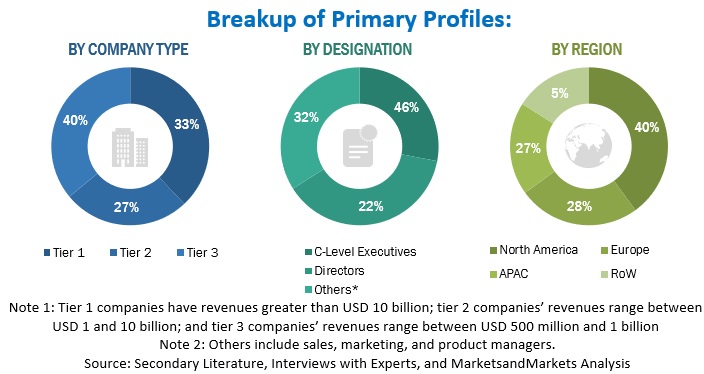
To know about the assumptions considered for the study, download the pdf brochure
Edge Data Center Market Size Estimation
We used the top-down and bottom-up approaches to calculate the edge data center market and its subsegments. We finalized the vendors in the market via secondary research and their segment shares in regions/ countries through extensive market research. This procedure included studying major market players’ annual reports and extensive interviews with industry leaders.
Top Down and Bottom Up Approach of Edge Data Center Market
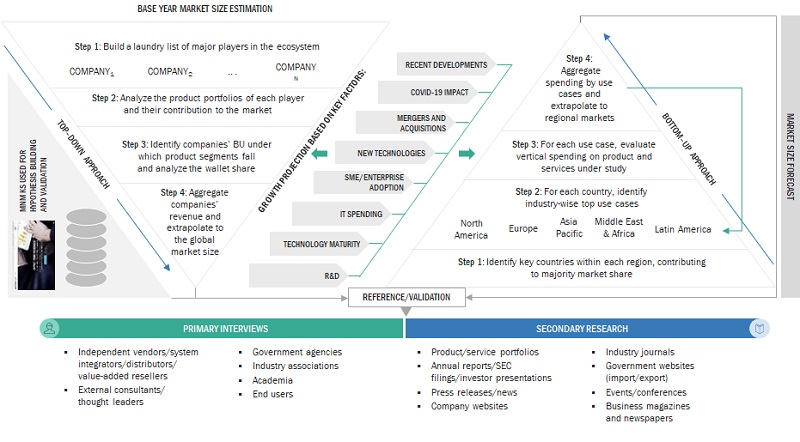
To know about the assumptions considered for the study, Request for Free Sample Report
Top Down Approach of Edge Data Center Market

Data Triangulation
In the market estimation process, we split the market into segments and subsegments after arriving at the total market size. We followed data triangulation and market breakdown procedures to determine each market segment’s and subsegment’s size. The data was triangulated by studying factors and trends from the demand and supply in IT & Telecom, BFSI, healthcare & life sciences, manufacturing, government, automotive, gaming & entertainment, retail & e-commerce, and others (mining & agriculture).
Market Definition
According to MarketsandMarkets, an edge data center, also known as an edge computing facility, refers to a decentralized computing facility closer to the data sources and the end-users it serves. Unlike traditional centralized data centers, often situated in larger urban areas, edge data centers are strategically placed near where data is generated and consumed. The primary purpose of edge data centers is to reduce latency, improve response times, and enhance the performance of applications/services that require real-time data processing.
Key Stakeholders
- Edge data center solution and service providers
- Professional service providers
- Cloud Service Providers (CSPs)
- Technology providers
- System Integrators (SIs)
- Value-added Resellers (VARs) and distributors
- Training and consulting service providers
- Information Technology (IT) infrastructure providers
- Component providers
- Support service providers
- Government organizations and standardization bodies
- Data Center providers
- Regional associations
- Independent hardware and software vendors
- End users
Report Objectives
- To define, describe, and forecast the edge data center market based on component (solutions and services), facility size, vertical, and region
- To provide detailed information about the major factors (drivers, opportunities, restraints, and challenges) influencing the growth of the edge data center market
- To analyze the opportunities in the market for stakeholders by identifying the high-growth segments of the edge data center market
- To forecast the size of the market segments concerning five main regions: North America, Europe, Asia Pacific, Middle East and Africa, and Latin America
- To analyze subsegments of the market concerning individual growth trends, prospects, and contributions to the overall market
- To profile the key players of the edge data center market and comprehensively analyze their market size and core competencies
- To track and analyze competitive developments in the edge data center market globally, such as product enhancements, new product launches, acquisitions, and partnerships and collaborations.
Available Customizations
With the given market data, MarketsandMarkets offers customizations per the company’s specific needs. The following customization options are available for the report:
Product Analysis
- The product matrix provides a detailed comparison of the product portfolio of each company.
Geographic Analysis
- Further breakup of the Asia Pacific market into countries contributing 75% to the regional market size
- Further breakup of the Latin American market into countries contributing 75% to the regional market size
- Further breakup of the Middle Eastern & African market into countries contributing 75% to the regional market size
- Further breakup of the North American market into countries contributing 75% to the regional market size
- Further breakup of the European market into countries contributing 75% to the regional market size
Company Information
- Detailed analysis and profiling of additional market players (up to 5)


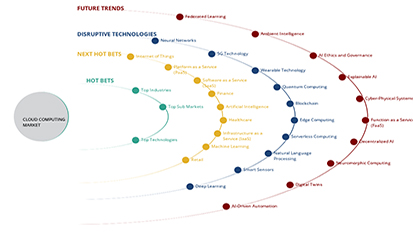

 Generating Response ...
Generating Response ...





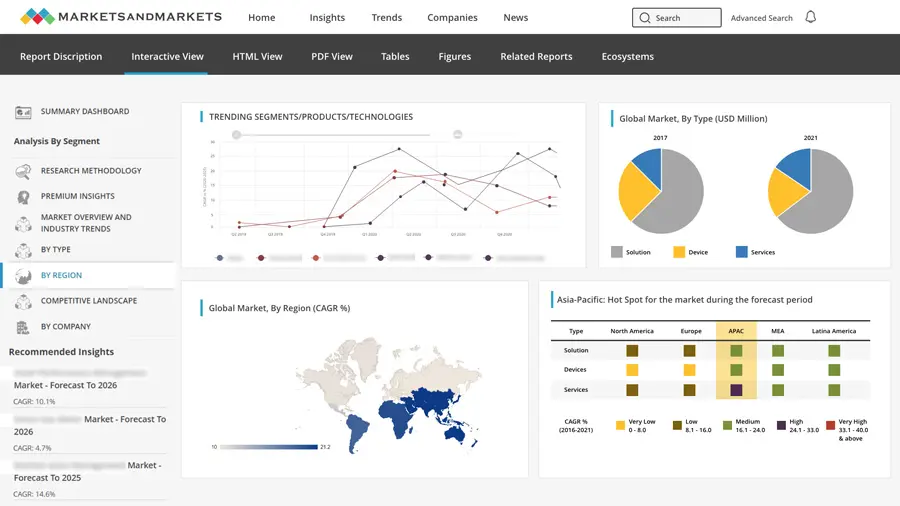
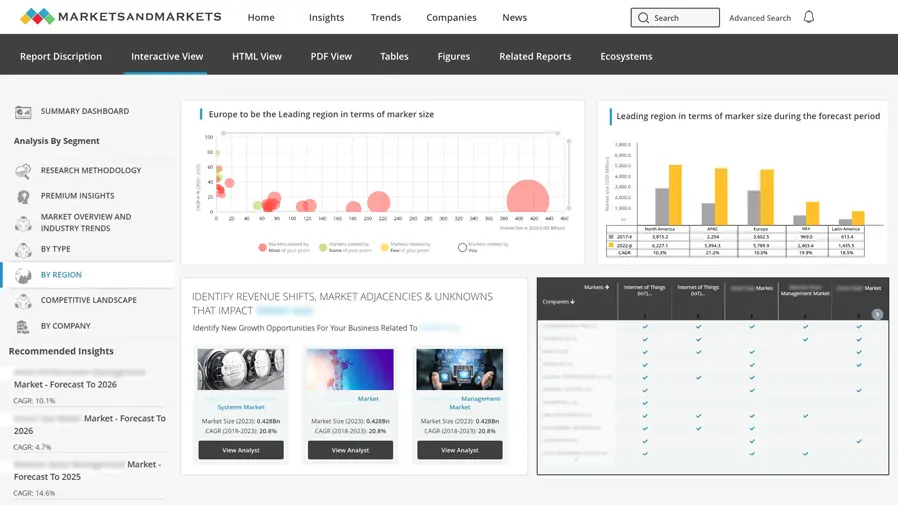
Growth opportunities and latent adjacency in Edge Data Center Market